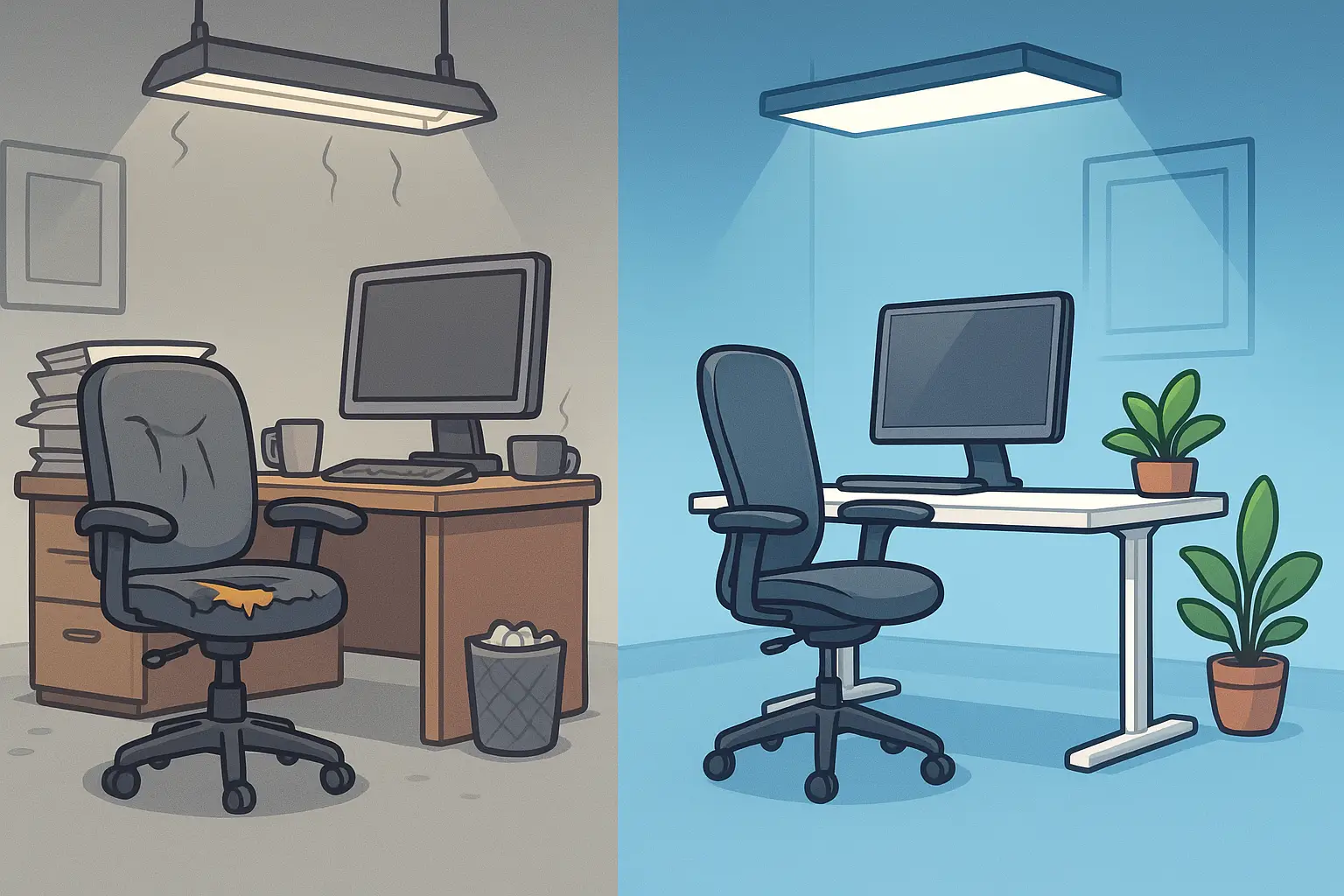
When you’re working to tight budgets, the appeal of low-cost office furniture is obvious: it lets you furnish more seats with less spend. But what which looks like a bargain today can quickly become a burden tomorrow. Cheap furniture often carries hidden costs — from frequent replacements to lost productivity — that overshadow the initial savings.
At Sapphire Business Interiors, we believe in helping clients see the true value of their furniture investments. It’s not just about upfront cost, but long-term performance, durability, and usability.
Cheap furniture typically compromises on materials, joinery, ergonomics, warranty and finish. Commercial-grade office furniture is engineered to withstand heavy usage, repeated reconfiguration, maintenance, and even relocation.
Here are some of the most common hidden costs associated with low-cost furniture:
Many budget chairs may only last 1-5 years under everyday commercial use before mechanical failure, structural problems, or comfort issues set in.
By contrast, well-made furniture (or good refurbished equivalents) can maintain functional, ergonomic, and aesthetic performance for 5-10+ years (or more) with proper maintenance.
The more you replace, the more you incur costs beyond the product itself. This includes delivery, disposal, downtime, installation, and reconfiguration. Some low-cost lines may lack warranties or parts supply, making repairs harder or more expensive.
Cheap materials often degrade faster: weaker fabrics, lower-grade finishes, plastic rather than metal reinforcement, poor mechanisms, weaker castors, etc.
Uncomfortable or broken equipment reduces staff satisfaction and may increase absenteeism or turnover. Ill-fitting chairs or poor ergonomics can lead to health issues, which in turn reduce productivity.
Sometimes what seems like a small issue (a squeaky chair, or a wobbly table) means bigger structural problems — but by then the product is already compromised or irreparable.
Replacing or repairing furniture often involves workplace disruption — moving staff, rearranging settings, dealing with deliveries, installation, and sometimes downtime.
Frequent reconfiguration or replacement drives extra project management, scheduling costs, and storage/logistics overhead.
Mismatched or substandard pieces might be incompatible with newer items, reducing flexibility or aesthetic consistency.
First impressions matter. Worn, mismatched or low-quality furniture can degrade the perceived standard and professionalism of a workspace. This may affect client perception, staff morale, and recruitment.
Conversely, well-chosen durable furniture supports wellbeing, encourages better posture, and reflects a commitment to quality and long-term thinking.
“Buy cheap, buy twice” is real — and faster disposal of furniture contributes to increased waste, higher disposal or recycling costs, and greater environmental impact.
Furniture that is designed for durability, repair, re-upholstery and reuse (or refurbishment) allows longer lifecycle, lower total cost, and less waste.
Rather than simply cutting cost, focus on value. Here’s how:
Specify for intended usage level and longevity
Understand how intense the use will be (desk hours, hot-desking, meeting rooms, breakout zones, heavy footfall, etc.).
Choose products designed for commercial use, and check expected lifespans and warranties.
Ask about component replaceability and spares support.
Prioritise ergonomics and comfort
Good comfort reduces fatigue, distraction and health issues, which impacts productivity.
Well-designed ergonomic furniture often reduces long-term staff costs (absenteeism, turnover, lower work satisfaction).
Plan for maintenance & future refresh
Build in service, re-upholstery or re-finishing options.
Consider refurbished or remanufactured options where appropriate — they can offer cost saving without significant compromise on quality.
Retain configuration flexibility so your layout can evolve without full refits.
Compare total cost, not just sticker price
Evaluate the cost per year of usability: how many years will this piece survive and perform effectively?
Consider installation, replacement, labour, disposal, downtime, and reconfiguration costs when comparing options.
When you work with Sapphire Business Interiors, we help you make informed decisions:
We balance initial cost and long-term value to suit your budget and expectations.
We help specify and source furniture that meets your performance, ergonomic and aesthetic needs.
We plan ahead for maintenance, refresh, and Day-2 support so that replacement cycles are minimised.
We help you avoid the hidden “tax” of cheap, disposable furniture, while ensuring your workspace reflects the standard your clients, staff and brand deserve.
Ready to explore furniture solutions that deliver real value, not just low upfront cost?
Let us help you balance budget, quality and longevity — and avoid the hidden costs before they hit.
📞 Contact Sapphire Business Interiors to discuss your next project and get expert advice on furniture strategy.
CALL US TO START CREATING YOUR DREAM Office